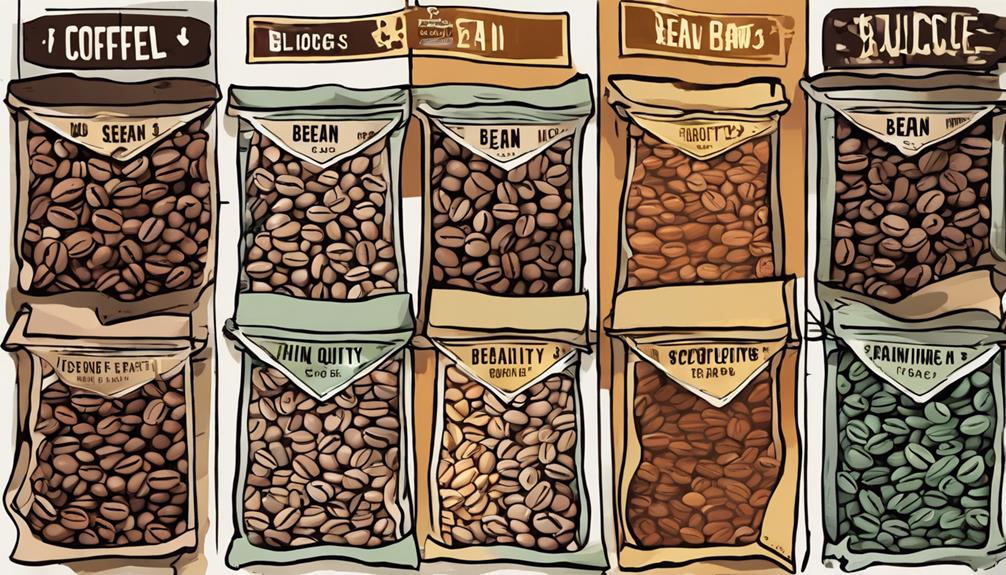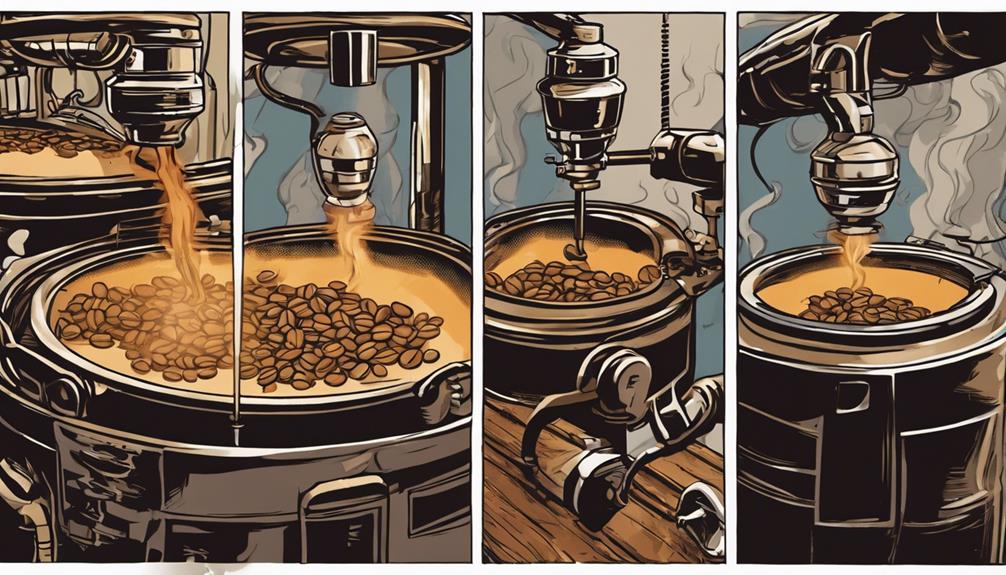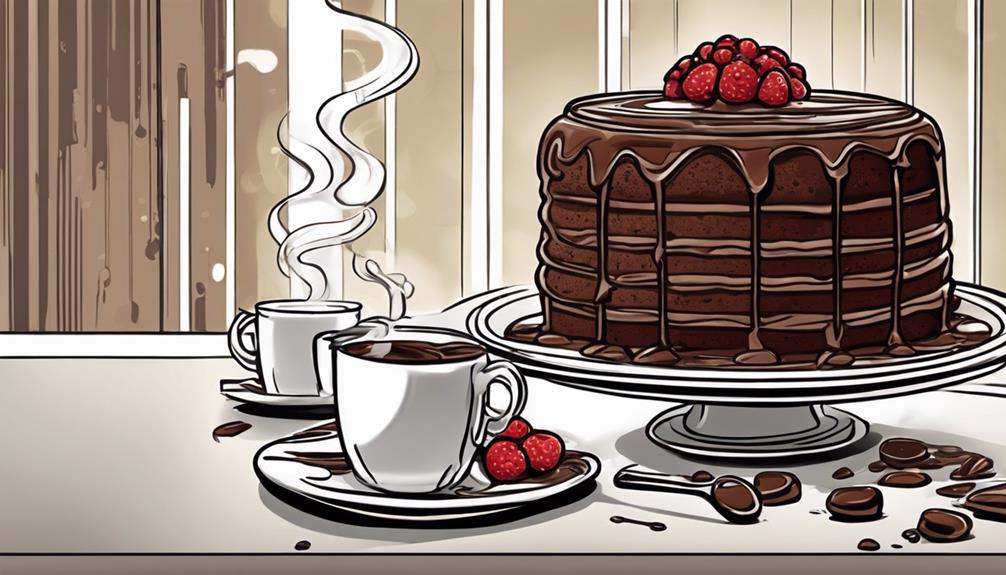To become an expert in coffee beans, explore different types such as Arabica, Robusta, Liberica, and Excelsa for unique flavors. Consider factors like preferred flavors, roast levels, and price ranges ranging from $5 to $20 per pound. Keep in mind that price indicates quality, origin, and sustainability. Store your beans in an airtight container away from light and air for optimal freshness. Focus on perfecting the roasting process; different roast levels impact taste, aroma, and flavor profiles. Dive deeper into mastering roasting techniques and flavor development. Cultivate a passion for roasting and strive for perfection in your craft to enhance your coffee expertise.
Key Takeaways
- Understand different coffee bean types and flavor profiles.
- Learn about roasting processes and roast levels.
- Master storage techniques to preserve bean freshness.
- Explore specialty coffee for unique taste experiences.
- Stay updated on industry advancements and trends.
Understanding Coffee Bean Varieties
To become a coffee beans expert, you must first understand the various coffee bean varieties available in the market. Arabica beans are renowned for their smooth, flavorful profile and are the most common type of coffee bean. They've a lower caffeine content compared to other varieties.
On the other hand, Robusta beans offer a more bitter taste with higher caffeine levels, making them ideal for espresso blends and instant coffee.
In the world of exotic beans, Liberica coffee beans stand out. These rare beans, primarily cultivated in Southeast Asia, boast a distinctive fruity flavor that sets them apart from more traditional options. Additionally, within the Liberica family, you can find Excelsa beans. These beans provide a complex taste experience, combining tart, fruity, and nutty notes that are sure to captivate the palates of adventurous coffee enthusiasts.
Understanding the nuances of each coffee bean variety is essential in selecting beans that align with your taste preferences and brewing methods.
Factors in Buying Coffee Beans

Understanding the factors when purchasing coffee beans is key to ensuring you get the perfect brew for your preferences. When selecting coffee beans, consider your preferred flavor profile and the roast level that best suits your taste.
Think about the type of coffee bean that aligns with the end product you desire, whether it be a bold espresso or a creamy latte. Single-origin beans offer distinctive flavors unique to their specific region, while blends combine different beans to create a harmonious taste profile.
When it comes to pricing, coffee beans can vary notably. Decent quality beans typically range from $5 to $10 per pound, while single-origin or ethical blends may cost between $10 and $20. Premium beans, on the other hand, can exceed $20 per pound.
Factors such as quality, origin, and sustainability influence the pricing of coffee beans, with single-lot crops from specific farms commanding top-tier prices. By understanding these factors, you can make an informed choice when purchasing coffee beans that suit your taste preferences and budget.
Pricing and Bean Quality

Consider the correlation between pricing and bean quality when selecting your coffee beans for the perfect brew. Price variations in coffee beans are influenced by factors such as quality, origin, and sustainability practices.
Decent quality beans, priced between $5 to $10 per pound, offer a good balance of affordability and flavor for everyday enjoyment. If you prefer higher quality and distinct flavors, single-origin or ethically sourced blends, ranging from $10 to $20 per pound, might be more suitable. These beans reflect a commitment to quality and sustainable practices.
For those seeking exceptional tastes, rare origins, and meticulous processing, premium coffee beans priced at $20 or more per pound are available. Keep in mind that single-lot crops from specific farms may command premium prices due to their limited availability and unique characteristics.
When purchasing coffee beans, understanding how price aligns with quality and origin can help you make an informed choice for your brewing needs.
Exploring Coffee Bean Types

You can expand your coffee knowledge by exploring various coffee bean types like Arabica, Robusta, Liberica, and Excelsa.
Each type offers distinct characteristics and flavor profiles that can enhance your coffee tasting experience. Understanding these differences can help you appreciate the diverse nuances of coffee flavors.
Bean Varietal Characteristics
Plunge into the world of coffee bean types by exploring the distinct characteristics of different varietals.
- Arabica beans are renowned for their smooth, mild flavor profile, offering hints of sweetness and acidity. They're the most popular variety, widely cultivated for their desirable taste.
- Robusta beans boast a bold, strong flavor with higher caffeine content and a more bitter taste than Arabica beans. This makes them perfect for espresso blends and instant coffee lovers seeking a robust kick.
- Liberica beans are rare gems with a distinctive fruity and floral flavor, primarily grown in Southeast Asia. Noted for their large, asymmetrical shape, they offer a unique coffee experience for those looking to explore something different.
- Excelsa beans, a type of Liberica, provide a complex flavor profile with tart, fruity, and nutty notes. Enthusiasts seek out this rare and exotic coffee for a truly exceptional tasting experience.
Flavor Profiles Overview
Exploring various coffee bean types reveals a diverse range of flavor profiles that cater to different taste preferences and brewing styles. Arabica beans are renowned for their smooth, mild flavor, often characterized by hints of sweetness and acidity, making them a favored choice among coffee enthusiasts seeking a balanced cup.
On the other hand, Robusta beans offer a stronger, more bitter taste profile with a higher caffeine content, commonly utilized in espresso blends to enhance the beverage's intensity.
Liberica coffee beans provide a distinctive fruity and floral flavor profile, originating from Southeast Asia and gaining recognition for their unique taste. Additionally, Excelsa coffee beans, a type of Liberica, boast complex flavors encompassing tart, fruity, and nutty notes, offering coffee aficionados a rare and exotic drinking experience.
Understanding the nuances of different coffee bean flavor profiles empowers individuals to select beans that align with their taste preferences and brewing methods effectively.
Tips for Storing Coffee Beans

To preserve the freshness and flavor of coffee beans, store them in an airtight container away from light and heat.
Here are some essential tips for storing coffee beans:
- Avoid the Fridge or Freezer: Refrigerators and freezers can introduce moisture to the beans, causing them to lose flavor. It's best to store coffee beans in a cool, dark place like a pantry.
- Choose the Right Container: Opt for an hermetic container to prevent air exposure, which can lead to staleness. Make sure the container has a tight seal to maintain freshness.
- Use Within a Month: While properly stored coffee beans can last 2-3 weeks after roasting, it's ideal to use them within a month for the best flavor experience.
- Maintain Optimal Quality: By following these storage tips, you can make sure that your coffee beans retain their peak quality and provide a delicious cup of coffee every time.
Finding the Right Beans

Consider your preferred flavor profile and desired end product when selecting coffee beans, as different varieties and roast levels offer distinct taste characteristics. For the best beans suited to your taste, explore the world of coffee through various types of beans such as Arabica and Robusta.
Arabica beans are known for their complex flavors and acidity, while Robusta beans provide a stronger, more bitter taste. Additionally, the roast level plays an essential role in determining the flavor, body, and acidity of your coffee. If you prefer a richer and bolder flavor, opt for a dark roast, whereas a light roast preserves the beans' original flavors.
Single-origin beans offer unique taste profiles from specific regions, while blends combine different beans for a harmonious flavor experience. Remember that prices can vary based on quality and sustainability factors, with premium options exceeding $20 per pound. Experiment with different beans, roasts, and origins to find the perfect match for your coffee preferences.
Enhancing Coffee Connoisseurship

Explore the world of coffee connoisseurship by expanding your knowledge of different coffee roasts, bean types, and flavor profiles. To enhance your coffee expertise, consider the following:
- Specialty Coffee: Plunge into the world of specialty coffee, where beans are carefully selected and roasted to bring out unique flavors and aromas that can elevate your coffee experience.
- Different Brewing Methods: Experiment with various brewing methods such as pour-over, French press, AeroPress, or cold brew to understand how each technique can influence the taste and characteristics of your coffee.
- Third Wave Coffee: Embrace the third wave coffee movement, which focuses on the quality and origin of the beans, the roasting process, and the art of brewing, to truly appreciate the complexities and nuances of your cup of joe.
- Coffee Drink Exploration: Broaden your coffee horizons by trying different espresso-based drinks like Americano, Macchiato, Cappuccino, and Latte to develop a well-rounded palate and deepen your appreciation for the diversity of coffee flavors.
Mastering Coffee Roasting

Mastering coffee roasting involves understanding the basics of the roasting process, the various roast levels, and the factors that influence flavor development.
By grasping these key points, you can enhance your skills and create a unique coffee profile that suits your taste preferences.
Stay tuned to uncover the secrets of achieving the perfect roast for your coffee beans.
Roasting Process Overview
The roasting process for coffee beans involves applying heat to transform green beans into aromatic, flavorful roasted beans. When mastering coffee roasting, keep in mind the following key points:
- Roasting Impact: Roasting times and temperatures play an essential role in shaping the coffee's taste profile. Shorter roasts retain more acidity, while longer roasts bring out richer flavors.
- Chemical Changes: As green coffee beans undergo roasting, they experience physical and chemical transformations. This includes the caramelization of sugars and the release of oils that contribute to the beans' aroma.
- Roasting Levels: Roasting levels range from light to dark. Light roasts maintain the bean's original flavors, while dark roasts offer bold, smoky notes.
- Roaster's Role: Coffee roasters carefully monitor the roasting process to achieve the desired roast levels. This attention to detail ensures uniformity and quality in the final product.
Understanding these aspects of the roasting process is vital for becoming a coffee beans expert.
Roast Levels Guide
Understanding the various roast levels in coffee is vital for honing your skills in coffee roasting. The roast level profoundly impacts the final flavor profile of the coffee beans, ranging from light roasts with their delicate and fruity notes to dark roasts known for their bold and smoky characteristics. Here's a handy guide to help you navigate the diverse world of roast levels:
| Roast Level | Description |
|---|---|
| Light Roast | Retains original flavors, light brown color |
| Medium Roast | Balances acidity and body, versatile for brewing methods |
| Dark Roast | Develops smoky and bitter notes, shiny black color |
As you experiment with different roast levels, keep in mind that the duration of roasting plays a pivotal role in achieving the desired roast level. Shorter roasting times are ideal for light roasts, while longer durations result in those rich dark roast flavors. Mastering these roast levels will empower you to create personalized coffee profiles tailored to your preferences.
Flavor Development Factors
To excel in coffee roasting, consider the key factors that influence flavor development in coffee beans. When roasting coffee beans, the flavor profile is greatly influenced by various factors:
- Temperature: The temperature at which the beans are roasted plays an important role in determining the final flavor. Different temperatures can bring out different flavor notes in the beans.
- Duration: The length of time the beans are roasted impacts the depth and complexity of flavors. Shorter roasting times may result in a more acidic and light-bodied coffee, while longer roasting times can lead to richer and bolder flavors.
- Airflow: Controlling airflow during roasting can impact the development of flavors. Proper airflow helps in even roasting and guarantees consistent flavor profiles.
- Maillard Reaction: Understanding how the Maillard reaction occurs during roasting is crucial for creating desirable flavor profiles. This reaction between amino acids and reducing sugars leads to the development of complex and rich flavors in coffee beans.
Diverse Bean Drinks and Methods

Explore a variety of bean drinks and methods to enhance your coffee expertise. Brewing coffee in different ways can introduce you to a world of flavors and textures. Start with a classic shot of espresso, a concentrated drink with a bold flavor and rich crema.
If you prefer something milder, try an Americano, which combines espresso with hot water for a smooth taste. For a balanced flavor profile, a Macchiato blends espresso with a touch of steamed milk, offering a hint of creaminess.
Cappuccino, an Italian favorite, mixes equal parts espresso, steamed milk, and milk foam for a creamy and frothy texture. If you enjoy a velvety mouthfeel, opt for a Latte, where espresso meets steamed milk and a thin layer of milk foam.
Experimenting with these different types of drinks will broaden your coffee horizons and deepen your appreciation for the diverse world of coffee.
Advancing in Coffee Roasting Career

To advance in your coffee roasting career, focus on honing your skills, staying updated on industry trends, and fostering a commitment to excellence.
Developing expertise and sharing knowledge with others can propel your professional journey forward.
Embrace continuous learning and aim for improvement to turn your passion for coffee roasting into a successful and rewarding career.
Career Growth Strategies
Developing expertise in sourcing quality beans, mastering roasting techniques, and refining flavor profiling skills is essential for advancing in your coffee roasting career.
To propel your career growth in coffee roasting, consider the following strategies:
- Continuous Learning: Stay updated on industry trends, attend workshops, and seek out certifications to enhance your knowledge and skills.
- Networking: Connect with other professionals in the coffee industry, participate in trade events, and engage in online communities to broaden your network and opportunities.
- Sharing Knowledge: Share your expertise with others, mentor aspiring roasters, and contribute to the coffee community to establish yourself as a respected figure.
- Commitment to Excellence: Aim for perfection in every batch, seek feedback to improve, and never cease honing your craft to stand out in the competitive coffee roasting landscape.
Essential Skills Development
To advance in your coffee roasting career, honing essential skills like sourcing beans, mastering roasting techniques, and maintaining quality control is imperative. In the dynamic world of coffee roasting, continuous learning plays a pivotal role in refining your craft and staying ahead in the industry. Embracing a mindset of perpetual growth and improvement is key to mastering the nuances of coffee roasting.
Quality control is the cornerstone of excellence in coffee roasting. Paying meticulous attention to every detail of the roasting process guarantees that the final product consistently meets high standards. By consistently evaluating and refining your quality control measures, you can elevate the taste and aroma of your coffee beans to delight customers and stand out in a competitive market.
Collaborating with peers and mentors can also enrich your coffee roasting journey. Sharing knowledge and experiences fosters a culture of learning and innovation, propelling you towards success as a skilled coffee roaster. Remember, passion, dedication, and a commitment to continuous improvement are the hallmarks of a rewarding career in coffee roasting.
Industry Advancement Tips
For advancing in your coffee roasting career, dedication to ongoing learning and the mastery of essential skills is crucial. To excel in the coffee world and advance your roasting career, consider the following industry advancement tips:
- Stay Updated on the Science of Coffee: Understanding the scientific principles behind coffee roasting and flavor development can elevate your skills and help you create exceptional roasts.
- Meet the Evolving Coffee Needs: Keep abreast of the changing preferences and trends in the coffee industry to tailor your roasts to meet consumer demands effectively.
- Engage with the Coffee Community: Sharing knowledge, experiences, and insights with fellow coffee enthusiasts can broaden your perspective, enhance your reputation, and open up new opportunities for growth.
- Embrace Continuous Improvement: Work for excellence in every roast, seek feedback for refinement, and always be open to learning and embracing challenges to advance in your coffee roasting career.
Frequently Asked Questions
What Is a Coffee Bean Expert Called?
A coffee bean expert is called a 'Q Grader.' You evaluate coffee quality based on aroma, flavor, body, and acidity. Your role is crucial for maintaining industry standards and providing insights to roasters and buyers. In addition to evaluating coffee quality, as a Q Grader, you also play a vital role in analyzing the sensory aspects of coffee beans and identifying any defects or inconsistencies. With years of experience and training, you can become a green coffee expert, utilizing your knowledge to advise on sourcing, roasting techniques, and flavor profiles for different types of coffee beans. Your expertise is essential for ensuring that consumers can enjoy high-quality, flavorful coffee in their daily lives.
How Do You Become a Coffee Expert?
To become a coffee expert, engage in cuppings, study roasts, and stay updated on trends. Experiment with brewing variables and seek mentorship. With dedication and practice, you'll refine your palate, deepen your knowledge, and master the art of coffee.
What Do You Call a Coffee Maker Expert?
You call a coffee maker expert a 'barista.' They are skilled professionals with knowledge of coffee beans, brewing techniques, and equipment. Baristas work in cafes and roasteries, crafting quality coffee beverages for customers.
What Is the Basic Knowledge About Coffee Beans?
You think you know coffee beans? Arabica and Robusta are the main types, with Arabica being the high roller. Roasting reveals those fancy flavors. Green beans pack a punch. Pick wisely for your taste buds.
Conclusion
You've learned all about coffee beans and how to become an expert in the world of coffee!
Did you know that there are over 100 different species of coffee beans, but only two main types, Arabica and Robusta, are widely used in the industry?
Keep exploring and experimenting with different beans to enhance your coffee connoisseurship and discover new flavors and aromas.
Cheers to your bean know-how!









